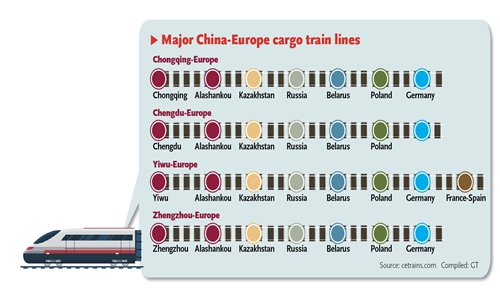
(Graphics/GT)
Shippers struggle to make profits as routes expand
The number of direct freight trains between China and Europe has been on a rise in recent years, buoyed mostly by policy support under the "Belt and Road" (B&R) initiative to rejuvenate the ancient Silk Road that connects the Eurasian region. But even as the rail links have improved significantly, shippers are struggling to find sufficient cargo to generate a profit.
The number of China-Europe cargo trains reached 5,000 as of Wednesday, after a train carrying everything from clothes to auto parts to electronics embarked on a two-week journey from Zhengzhou, capital of Central China's Henan Province to Hamburg, Germany, State broadcaster China Central Television (CCTV) reported on Thursday.
Since the first direct train linking Southwest China's Chongqing to Duisburg, Germany was launched in March 2011, there have been 52 routes established between 32 Chinese cities and 32 cities in 12 European countries, according to the CCTV report.
Most of the trains originating in cities such as Zhengzhou, Chongqing and Yiwu in East China's Zhejiang Province travel through Alashankou port in Northwest China's Xinjiang Uyghur Autonomous Region or via Erenhot and Manzhouli ports in North China's Inner Mongolia Autonomous Region and arrive in European cities such as London and Madrid.
As of Thursday, 3,800 trains had passed through Alashankou, which is on the China-Kazakhstan border, according to local officials.
"We started to inspect one China-Europe train every month, then one every week and now we inspect four or five each day," Li Hong, an official at Alashankou Customs, said in a statement sent to the Global Times on Thursday.
The increasing number of trains through Alashankou has boosted trade and local industries, according to Wang Yong, a deputy Party chief of Alashankou city. "Trade volume and throughput have been increasing at 50 percent annually," Wang said in the same statement.
In the first four months of 2017, trade through Alashankou surged 56.3 percent year-on-year to $3.32 billion, while freight increased 14.6 percent to more than 6.6 million tons, according to data released by Alashankou Customs in May.
Direct trains have helped companies save time and money in getting their products to Europe or bringing European products to China, said the CCTV report.
The trains have also cut logistics costs by 30 percent, and the travel time is now 10 days as opposed to 15 days or more via other modes of transportation, CCTV reported.
Direct trains also boost profit margins for freight forwarders, compared with seaborne transport, according to an official of COSCO International Freight Co, the CCTV report said.
But many operators of these cargo trains said that profit margin is small and it's hard to find cargo to fill up the containers as more and more routes are launched.
"It has been developing too fast. The cake is only this big and everyone is trying to get a piece," said Yan Hong, deputy general manager of Hao International Logistics Co, which operates a direct train between Harbin, capital of Northeast China's Heilongjiang Province and several European cities. "There are many overlapping routes."
Yan said that even if companies find enough cargo to carry to Europe, the return train may be empty. "There just isn't enough cargo, at least for now."
He said his company has mostly carried cars and parts for automaker Volvo, but is still trying to find other ways to fill up the trains, including doing trade on its own.
Feng Xubin, chairman of Yiwu Timex Industrial Investment Co, told the Global Times that finding enough cargo is a challenge, among many other difficulties, including the need to change containers a few times due to different track gauges and requirements in different countries and regions.
Companies have called for a more coordinated system to run the China-Europe trains to improve efficiency and save costs.


















































